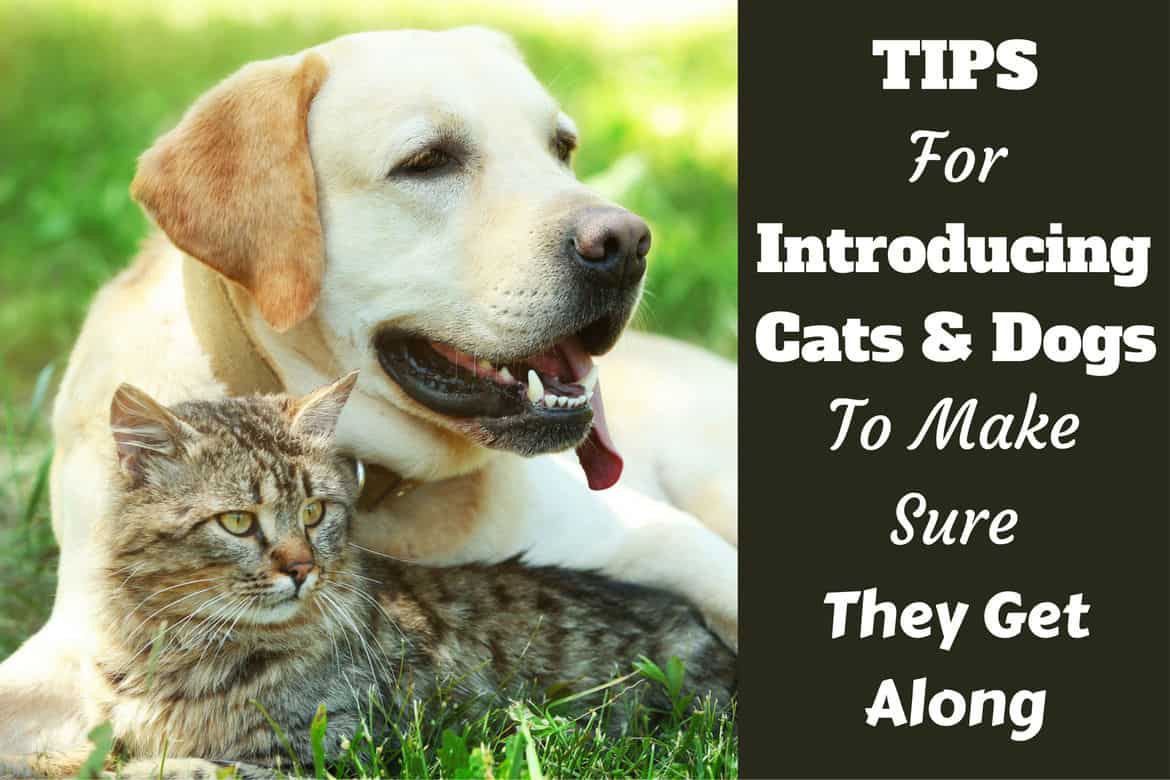This post may contain affiliate links. We may earn money or products from the companies mentioned in this post.

The world of pet owners can be divided into two categories: cat lovers, and dog lovers. That’s all. Period. (Just ignore all those rodent, reptile, bird/parrot, and fish people.)
Or can it? Is there, in fact, a third category: cat AND dog lovers?
While statistics are difficult to find, what is known is between 37-47% of all households in the United States have a dog, and 30-37% have a cat. Given these numbers, it’s almost certain there’s a reasonable amount of overlap.
The term, “fighting like cats and dogs,” is one we’re all familiar with, and if you’ve ever seen it happen, you know why it’s the benchmark for all manner of squabbles.
Happily for those who truly are dog and cat people, it is entirely possible for these two species to live together in peace, and even harmony.
If you feel you’re a member of this special group, or if your cat-person/dog-person relationship has come to the inevitable crossroads, read on to discover how your favorite pets can happily coexist.
Contents & Quick Navigation
Introducing a New Cat to a Resident Dog
For the sake of argument, lets assume you already have a Lab at home (which might be why you’re at this website) and you’ve decided to bring home a cat.
Excellent choice! There are many cats in need of homes out there, so you’re doing a good thing.
Sink or Swim
However, to simply open the door to your dog’s domain and toss in a cat may lead to trouble.
An exuberant Labrador can readily kill a cat, even without meaning to. Have you ever seen your Lab shake a stuffed toy around? Imagine what that could do to a cat!
Labs are typically very patient dogs that tend to just roll with whatever is thrown at them.
This is especially true of anything the people your dog loves and trusts care to do to it – my own Black Lab won’t even flinch when the kids pull his lips back into a smile, or put their socks on him to dress him up.
When it comes to other species of animals, however, even the most laid back Lab can snap.
The videos people post of dogs curiously sniffing kittens might be adorable, but the truth is, unless the two animals have already been acclimated to one another, the owners are playing Russian Roulette with the cat’s life.
Be Prepared
Before bringing home kitty, there are some preparatory steps you should take.
First and foremost, your Lab needs to be responsive to basic voice commands such as ‘sit,’ ‘stay,’ ‘lay down,’ and ‘off’ (or with my dog, it’s ‘leave it’). It is imperative that you’re able to control your dog before adding a cat into the mix.
Next, have everything your cat will need to make it comfortable: food and water dishes, a litter box, toys, a bed, and if you have the space, a cat tower.
Also, Kristen from Friendly Claws advises how it’s a good idea to keep all these items for you kitty in a single room where your cat can be kept in isolation, at least at first.
Having a space to call his or her own and feel secure will help them feel at home even with dogs around.
Methods For Introducing A New Cat To Your Labrador

Here are a couple of different methods you can use for successfully introducing your pets:
The Table Top Method
This 4-step system takes advantage of a cat’s natural inclination to view the world from up high. You’ll need a table, a crate for your dog, and a leash.
Your best bet is to start with a calm dog. If this is not your dog’s natural state, take him out for a long walk, or exercise him thoroughly to tire him out before the meeting takes place.
Step One: Crate and Table
Crate your dog and then give him a little praise so he knows he’s not being crated for doing anything wrong.
Now bring your cat into the room and place it on a table where it can see the dog, but not so close that it might feel intimidated. If the cat prefers to be held, that’s fine.
If not, and if it’s not inclined to stay on the table, place the cat in a carrier facing the dog. Offer treats to both your pets while they simply observe each other.
If either one seems nervous or agitated during their meeting, you’ll need to repeat this first encounter until they’re both relaxed. Keep the cat isolated from the dog between meetings.
For this, choose a room in your home where the cat is completely separated from the dog, and place the litter box, food, toys, and any cat furniture you may have in the room.
Step Two: Leash and Table
Once they’ve shown they can be in the same room together without undue stress, you’re ready for the next step. Once again, place the cat on the table and provide an ample supply of treats.
Ensure your dog is calm, and bring it into the room on a leash. Have your dog sit, and give him a treat. So long as both remain calm, continue to give them treats, and gradually move the dog closer to the table.
If it helps the cat relax, you can have your Lab lie down between movements.
Keep this up until the animals are just a couple of feet apart. Keep having visits like this until it’s clear they’re comfortable with each other, increasing the length of the visit each time.
Step Three: Unleashed
As you may have guessed, the next phase sees your dog visiting off-leash.
The key safety tip for this stage is to make sure the cat has an escape route.
An off-leash dog is not easily controlled should it decide to lunge, or if it reacts badly to any perceived aggression from the cat.
Therefore, you must ensure that there is a high place the cat can get to, or someplace for it to hide within easy reach.
If this meeting does not go well, just back up to step two until you feel they’re ready to try again.
Step Four: Unsupervised
Once you’ve had several (many) successful meetings off-leash, you’re ready to let them interact without supervision.
As before, be sure the cat has a place it can escape to if it becomes uncomfortable, or should your Labrador become too aggressive.
Begin with very short visits, and gradually increase their duration until you feel they’re ready to live their lives together.
The Dinner-for-Two Method
For this 6-step system, you’ll be taking advantage of your Lab’s love of eating to create a positive association with your new cat.
Step One: Preparation
Set up your new cat’s isolation room and spend time with it in there. This gives your cat a chance to settle in and get used to you.
How long this takes will vary from cat to cat, but however long it takes, ensure the dog is kept well away.
Step Two: The Blind Dinner Date
Set up the cat and the dog’s feeding stations on opposite sides of the closed door to the isolation room.
The idea is that in time, both animals will associate the smell and sound of their housemate with food, something they both enjoy.
Should your dog be overly interested in what’s on the other side of the door and begin fussing (barking or whining, scratching at the door), tell it ‘no’ and move the dog’s food back from the door.
Bring your Lab away from the door (on a leash if you have to) and have him eat at a distance. At the next feeding you can move the dog food closer to the door. Keep this up until both pets are eating calmly at the door.
Step Three: Cat In A Box
Whether you have a dog or not, it’s a good idea to get your cat accustomed to being in a crate or pet carrier anyway.
Choose a container big enough for the cat to stand up, move about, and turn around in.
Make it cozy inside, and use treats or food to coax the cat inside. Short durations, several times a day should acclimatize your cat in short order.
Once your cat can enter the container without stress, you’re ready for the next stage.
Step Four: Cat In A Box, Dog On A Leash
Much like in the previous method, you’ll now be bringing the two pets into the same room, with the cat in a carrier and your Lab on a leash.
First bring your cat into the chosen meeting room (not the isolation room) and coax it into its carrier or crate.
Once it’s secure and relaxed, bring in your dog on a leash. Don’t bring them close together; they only need to see each other for now. Have your dog sit or lie down in view of the carrier.
They should be familiar with each other’s scent from step two, so while they’ll be curious, neither should be frantic.
If either seems overly agitated, however, take the dog out of the room. Verbally discipline your Lab, if he’s acting aggressive, or failing to respond to your commands.
Once your dog has calmed down, you can try bringing it back in again for another go. Keep training sessions short, maybe 3 minutes or so. Be sure to offer copious amounts of praise for a successful session!
As your sessions progress, bring your two pets closer together until they can be right next to each other without getting rattled.
If they can manage to stay calm around each other for at least 30 minutes, it’s time to take this relationship to the next level.
Step Five: Dog On A Leash, Cat On the Loose
For this stage you’ll need a partner to help you, preferably someone both pets already know and are comfortable with.
Begin step five just as you did step four: your cat is in a container, and your Lab is leashed and sitting/lying down and staying.
When everyone is ready, have your partner open the door of the cat’s container. If it’s not interested in coming out, offer some food or treats as a lure. All the while, your Lab should still be calm by your side.
Whatever the cat does, it’s important that your dog remains calm and under control, even if the cat runs and hides. Offer your dog plenty of praise and treats for good behavior.
If all goes well, then after about 2 weeks (there’s no hard and fast rules about this, you simply have to gauge your pets’ tolerance for one another) you will all be ready for…
Step 6: Free Range Pets!
By now your dog and your cat should be relaxed and comfortable around each other.
They may play together, but it’s just as likely that they’ll largely ignore one another. That’s perfectly fine! The point is for everyone (including yourself!) to be able to coexist stress-free.
Still, we recommend erring on the side of caution and keeping them separated when you’re not home. Close doors, use crates, set up barriers, or baby gates – whatever works best in your home.
Do this for maybe another month or so, until you’re absolutely convinced that your Lab isn’t going to hurt the cat, even accidentally.
Congratulations! You’ve now conquered the great Cat/Dog divide and brought peace to your home!
Introducing a New Dog to a Resident Cat

Ah, but what if it’s the other way around? What if you already own a cat and have made the brilliant decision to open your home to a loving Lab?
The process is not dissimilar to what’s described above, but there are some slight differences.
In the same way that the first two methods gave the advantage to your resident dog, the opposite is true when it’s the cat that’s already at home.
It’s important to make the resident pet feel nothing has been taken from it: no loss of freedom or privileges.
Be Prepared, Differently
As outlined in the first section, it’s important to create a ‘safe room’ for your cat to escape to should it feel threatened. It needs to be inaccessible to your dog, and the best way to do this is with a small cat door.
If you’re bringing home a puppy, take it to obedience classes as soon as possible.
And if you take ownership of an adult dog, be sure you know its commands and it obeys them. A dog that doesn’t know obedience commands will be very difficult to manage around a cat.
As awful as it may sound, cat poop coated in litter is an irresistible treat to some dogs.
If your dog frequents the litter box too often, your cat may become afraid of this location and start relieving itself elsewhere. Your best bet is to keep the litter box somewhere the dog cannot get to it. (And it’s just plain gross!)
Keep feeding areas separate, too. Labs are indiscriminate eaters, but if they’re filling up on cat food, they won’t get the proper nutrients they need. You also create a potential zone for cross-contamination should one or the other fall ill.
Most techniques for a smooth introduction of a dog to a cat follow steps similar to these:
Step One: Tired and Full = Relaxed
Exercise your new Lab and give him something to eat. He’ll be relaxed, content, and ready to face a new situation in a calmer manner.
Step Two: Cat Out of Sight
With your cat safely waiting in a secure room, allow your dog to wander about the house for about half an hour. This gives him a chance to get the lay of the land, and catch the scent of the cat.
Your new dog now knows there’s someone else already at home, but without the cat being visible, he’ll be curious rather than excited.
Step Three: Dog Out of Sight
Reverse the above process and have your dog out of the house for a bit while your cat discovers the new smell in its home. Now your cat and dog have “met” without laying eyes on each other.
Step Four: Leash Your Lab
Keep your new Lab on a leash in the house and keep them with you at all times, if the cat is present.
Alternatively, you can keep them separated and have scheduled visits as outlined earlier in the article. Allow your cat to roam free while your Lab remains sitting or lying down at your side.
Offer words of comfort and praise to them both, and give treats for good behavior. Correct any attempts by your dog to spring towards the cat or behave in an aggressive manner.
Your cat may hiss and growl, but that’s natural. In fact, a swat on the nose from an annoyed cat might be just what your dog needs to convince it not to pester its housemate!
Step Five: Together At Last
Once both pets have shown themselves capable of getting along, or at least ignoring each other (and this will likely take many repeats of step four), you can move on to unleashed visits.
Keep visits short, be ready to intervene, and interact with your dog to keep it happy and distracted.
Gradually allow your Lab to do its own thing and act as an observer as the two share the same space. Soon you’ll find that they no longer need supervision.
Conclusion
And there you have it – peaceful coexistence between arch-rivals since the dawn of recorded history!
Well, maybe it’s slightly less epic than that, but its still a great accomplishment. Enjoy the extra love in your home as you scoff at the naysayers who called you crazy.
Disclaimer
All content on this site is provided for informational and entertainment purposes only. It is not intended to be nor can it be considered actionable professional advice. It must not be used as an alternative for seeking professional advice from a veterinarian or other certified professional.
LabradorTrainingHQ.com assumes no responsibility or liability for the use or misuse of what’s written on this site. Please consult a professional before taking any course of action with any medical, health or behavioral related issue.
Save to Pinterest:

Top Picks For Our Dogs
- BEST PUPPY TOY
We Like: Calmeroos Puppy Toy w/ Heartbeat and Heat Packs - Perfect for new puppies. Helps ease anxiety in their new home. - BEST DOG CHEW
We Like: Bones & Chews Bully Sticks - All of our puppies love to bite, nip, and chew. We love using Bully Sticks to help divert these unwanted behaviors. - BEST DOG TREATS
We Like: Crazy Dog Train Me Treats - One of our favorite treats for training our service dog puppies. - BEST FRESH DOG FOOD
We Like: The Farmer's Dog - A couple months ago we started feeding Raven fresh dog food and she loves it! Get 50% off your first order of The Farmer's Dog.
For a list of all the supplies we get for our new service dog puppies check out our New Puppy Checklist on the PuppyInTraining.com blog.
4 comments
Years ago, my younger sister was bitten and scratched by a stray cat even when she did absolutely nothing at all. Since then, we didn’t consider adopting cats to our home again. All of us in the family are dog lovers, we have 1 adult dog and 2 puppies. My problem isn’t introducing a cat to our adult dog, but it’s introducing the newest puppy who’s quite weaker than the other one. Our adult seems to not welcome this new puppy of ours :( If you have any suggestions, please do tell!
Hi Mary,
It can take time for an adult dog to accept a new puppy, sometimes quite a long time and with there being some tellings off that may look frightening along the way. Just supervise their time together, make sure the puppy isn’t allowed to hassle the adult dog too excessively, and do not scold your adult dog for telling off the puppy – which will happen, and quite a lot at first. They should sort themselves out and become friends in time, once they are used to eachother and your adult dog has drilled into the puppy how he wants them to behave and respect his space.
Hopefully the tips in this following article will help: https://www.labradortraininghq.com/labrador-puppies/introducing-puppy-or-dog-to-your-labrador/
All the best!
Wow! I didn’t know how much work it takes to introduce them, and probably keep them happy after! I also know of some cats who are very chill with dogs, so I guess it just depends.
really neat post